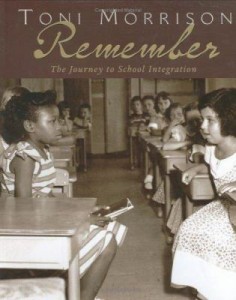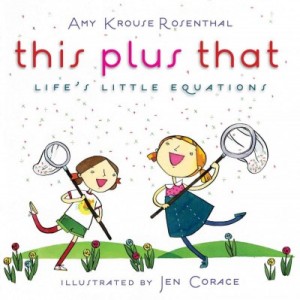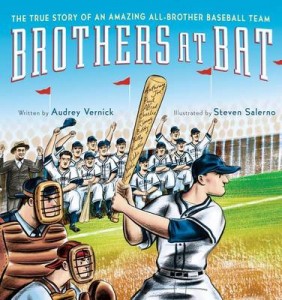Peace
 It has been twelve years since the terror attacks on 9/11. Most of the students in elementary classrooms today weren’t even born yet in 2001, so how do we commemorate that day with kids? The kindest way I can think of to honor the lives that were lost is to promote peace, and the most beautiful book I know about peace is this one.
It has been twelve years since the terror attacks on 9/11. Most of the students in elementary classrooms today weren’t even born yet in 2001, so how do we commemorate that day with kids? The kindest way I can think of to honor the lives that were lost is to promote peace, and the most beautiful book I know about peace is this one.
Peace by Wendy Anderson Halperin combines art, poetry, and quotes to help answer the question “how do we make a peaceful world?” The book is quiet and thoughtful, with detailed pictures your students will want to spend time examining close up. You can read aloud the main thread of the poem, which begins with
“For there to be peace in the world…/ …there must be peace in nations./ For there to be peace in nations, there must be peace in cities.”
and then take time to read all the beautiful quotes threaded throughout.
“It’s not so much the journey that’s important, as the way we treat those we encounter and those around us, along the way.” – Jeremy Aldana
Wendy Anderson Halperin has a beautiful website that extends the book: drawingchildrenintopeace.com. She has cool videos where she teaches kids how to draw different peace symbols and she talks about conflict resolution. You can even browse through a gallery of art where kids have drawn and written what peace means to them.
I hope you share Peace with your students. I hope you take time to discuss some of the beautiful quotes, not just because it works for Range of Reading and Craft & Structure, but because they may plant hopeful seeds in your students. If your students choose a quote to illustrate, or write a peace quote of their own and add pictures, you can send it to Wendy Halperin, and send it to me, too. I am all about sharing peace.
For more information about the author/illustrator, please visit wendyhalperin.com.
Read MoreWords with Wings
This novel-in-verse is for the daydreamers and for the teachers who want to guide, not squash, those who have such vivid imaginations.
Words with Wings by Nikki Grimes is one of those gorgeously-written books you can read aloud to your class for wonderful group discussions and then watch them eagerly grab it to read independently. (Novels-in-verse are not only a great way to immerse your students in poetry, but it hits both Range of Reading and Fluency for Core Standards. Woohoo!) Imagine yourself reading aloud this page to your students and knowing that for some kids, it will hit home:
First Day
I duck down in the seat
of my new class.
To these kids,
I’m not Gabby yet.
I’m just Shy Girl
Who Lives
Inside Her Head.
No one even knocks
on the door
for a visit.
They don’t know
it’s beautiful
in here.
Gabby is a daydreamer, which sometimes causes problems in school and at home. But how can she help daydreaming, when words have wings? Some of the poems would make for great writing prompts in your classroom, like this one:
Waterfall
Say “waterfall”
and the dreary winter rain
outside my classroom window
turns to liquid thunder,
pounding into a clear pool
miles below,
and I can’t wait
to dive in.
To my absolute delight, Nikki Grimes named the teacher in this book Mr. Spicer after one of the coolest teachers I’ve ever meet, Ed Spicer. He teaches first grade here in Michigan and he is committed to giving his students time to daydream. Sometimes he plays music, sometimes it’s quiet. Sometimes he asks his students to write about their daydreams, or turn and talk about them, or daydream on a particular topic, like a science concept they are studying. I love the power of daydreaming and I adore Ed Spicer for encouraging his students to take a few moments to let their minds wander. Follow him on Facebook for more about his classroom because he is a wealth of amazing ideas.
So share Words with Wings with your students. For a quick Craft & Structure lesson, talk about the words Nikki Grimes chose that have “wings” for Gabby. Why did she choose these words? What words have wings for you? Give your students a few minutes just to daydream, wonder and imagine. It may become a favorite break in your classroom.
Happy September, everyone!
For more information about the author, please visit: nikkigrimes.com.
Read MoreRemember: The Journey to School Integration
 Yesterday was the 5oth anniversary of the March on Washington and Dr. Martin Luther King, Jr.’s speech “I Have a Dream”. School starts for most Michigan students next Tuesday, and I wonder how many of those students realize that there was a time when many school doors were closed to kids who weren’t white.
Yesterday was the 5oth anniversary of the March on Washington and Dr. Martin Luther King, Jr.’s speech “I Have a Dream”. School starts for most Michigan students next Tuesday, and I wonder how many of those students realize that there was a time when many school doors were closed to kids who weren’t white.
Remember: The Journey to School Integration by Toni Morrison is a powerful and poignant nonfiction book full of photographs that bring to life this time in American history. We see a photo of a little African-American girl with a bow in her hair, reading from her school book, and Morrison writes, “The law says I can’t go to school with white children. Are they afraid of my socks, my braids? I am seven years old. Why are they afraid of me?”
We see three white boys wearing cardboard signs that say things like “WE WON’T GO TO SCHOOL WITH NEGROES” and Morrison writes, “I don’t know. My buddies talked me into this. They said it would be fun. It’s not, but these guys are my friends and friends are more important than strangers. Even if they’re wrong. Aren’t they?”
We see a white teenage girl and an African-American teenage girl smiling at each other at a school lunch table. We see a group of students with a variety of skin colors gathered around a picture book. Morrison includes information about Brown vs. the Board of Education, a timeline, and notes on each photo at the end of the book, but even if you just share the photos and the captions, this book will spark discussions (and hit that CCSS of Range of Reading.)
Since this is a book about something that happened before your students were born, why share it? In Morrison’s words, “Why offer memories you do not have? Remembering can be painful, even frightening. But it can also swell your heart and open your mind… the path was not entered, the gate was not opened, the road was not taken only for those brave enough to walk it. It was for you as well.”
So share this beautiful book with your students. Make time for thoughtful, respectful discussion. There’s a free teacher’s guide on houghtonmifflinbooks.com with discussion questions and research ideas. Encourage your students to put themselves in the shoes of kids who had to struggle for access to a good education. Take inspiration from the powerful photos you’ve seen. Bring a digital camera into your classroom so your students can take photos of each other and themselves and write, as Morrison did, what they think the person in the photo was thinking. Celebrate the fact that each and every one of your students is safe and welcome in your classroom.
Read More
Go Out and Play!
 Go Out and Play! Favorite Outdoor Games from KaBOOM! is like a chocolate-covered peanut butter cup: it combines two good things to make something wonderful, and it is something I cannot resist.
Go Out and Play! Favorite Outdoor Games from KaBOOM! is like a chocolate-covered peanut butter cup: it combines two good things to make something wonderful, and it is something I cannot resist.
The peanut-butter-part: Go Out and Play! is a nonfiction book, so sharing it with your students hits that Range of Reading Common Core Standard. Use the the table of contents (nice informational text feature) to help you choose from the dozens of games listed. Use the key at the bottom of each page (another nice informational text feature) to see how many players you’ll need, the recommended age group, how large an area you’ll need, and what, if any, materials you’ll need. Each game has one short page of information explaining how it is played. To build informational reading comprehension, give each student or group of students a page from the book to read. Each group can teach the class how to play that game. (Key Ideas and Details? Check!)
The chocolate part: Go Out and Play! will make your students want to go out and play. So yes it’s an informational book for teaching reading skills, but it’s all about games and playing outside – woohoo! Physical Education teachers will want to keep a copy all to themselves, but get one for your classroom, too, so when your students (or you) need a brain break you can grab this book and play.
When I saw that the author of this book is “KaBOOM!”, I did a little research. “KaBOOM! is a national non-profit dedicated to saving play for America’s children. Our mission is to create great playspaces through the participation and leadership of communities. Ultimately, we envision a place to play within walking distance of every child in America.” Now I like the book even more.
So, choose a game from Go Out and Play! Read how to play the game to or with your students. Then (at the risk of sounding like my mother) go out and play!
For more information about KaBOOM! and its mission to encourage outdoor play, please visit: kaboom.org.
Read MoreMy First Author Gig
Next week I am speaking to a group of elementary teachers about writing and publishing. It’s my first gig speaking as an author to a group of adults. I am 1/3 nervous, 1/3 excited, 1/6 fearful that I will be revealed as an imposter, and the leftover bits feel like I’ve been preparing for this for a long time.
And, according to the ancient documents I found while moving, I have been preparing for my place in the book world since at least second grade. The lesson here is to encourage your students’ passions because it may be the path of a future career. Tell students to save their work so they can look back one day on who they used to be. And most importantly, teach students to write daily affirmations like “I have a nice complexion.” These will come in handy during the tough teen years.
Read MoreBrothers at Bat
Because it is baseball season (go, Tigers!) and because I just found out that I get to go back to New Jersey in September to teach a seminar for preschool and kindergarten teachers, this week I’m featuring a book about baseball written by one of my favorite Jersey girls.
Brothers at Bat: the true story of an amazing all-brother baseball team is written by Audrey Vernick and illustrated by Steven Salerno. In 1938, the twelve Acerra brothers formed their own semi-pro baseball team. With their dad as their coach, the brothers went on to win league championships four times, and earned a place in the Baseball Hall of Fame as the longest-playing all-brother baseball team. Salerno’s art perfectly captures the feel of the 1930s and 1940s. I love the photo at the end of the book showing all the brothers in uniform.
More than just a book about an interesting bit of baseball trivia, the heart of this story is how the brothers were a team for life, both on and off the field. “As the younger brothers grew up,” Vernick writes, “the older ones shared playing time.” When Alfred loses an eye due to a bad bounce of a baseball, his brothers work with him so he can rejoin the team. “He was a pretty good catcher for a guy with one eye,” one brother says. You can discuss with your students all the examples of teamwork in this book to hit the Common Core State Standard of Key Ideas and Details. Talk about teamwork in your classroom. Your students can each make a “baseball” card for themselves, and even team uniforms with white t-shirts and Sharpie markers! Take your students outside for a game of catch with the little bouncy balls from the dollar store. You’ll build hand-eye coordination, cooperation skills, and a sense of teamwork in your classroom. Play ball!
Audrey Vernick has a curriculum guide with lots of discussion questions and ideas on her website: audreyvernick.com. On Steven Salerno’s website you can see some of the illustrations for this book in process: stevensalerno.com.
Read MoreThis Plus That: Life’s Little Equations
 Not only is this week’s picture book a fun way to teach some of the Common Core State Standards in Reading, it is also the best inspiration for your “welcome back to school” classroom bulletin board.
Not only is this week’s picture book a fun way to teach some of the Common Core State Standards in Reading, it is also the best inspiration for your “welcome back to school” classroom bulletin board.
This Plus That: Life’s Little Equations written by Amy Krouse Rosenthal and illustrated by Jen Corace is sheer brilliance. It starts with:
1 + 1 = us
I love it! Not only will your students know how to read math symbols after sharing this book, but they’ll look at math much more creatively.
Smile + wave = hello
Smile + ocean wave = beach
Some are compare and contrast (I love what does and does not equal a sincere apology!), some are stand-alone sentences. Most are addition, but other math ideas come into play as well:
cozy + smell of pancakes – alarm clock = weekend
This would be fun to pair with 1 + 1 = 5 by David La Rochelle and Brenda Sexton if you’d like to hit Integrating Knowledge & Ideas, but all on its own This Plus That teaches Print Concepts and works beautifully to build Fluency.
After you share This Plus That, brainstorm and write equations with your students. In the book:
leaves + hot soup = fall
What things add up to fall for your students? And I’d love to make a welcoming bulletin board with:
1 + 1 = us and Joe + Gabriel + Julia + Matt…. = our class
This Plus That + your students = a whole new way of writing with math symbols!
For more information about the author, please visit whoisamy.com.
For more information about the illustrator, please visit jencorace.com.
Read More










